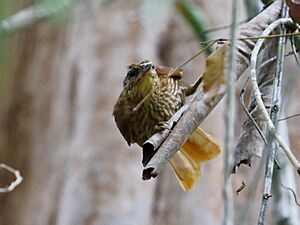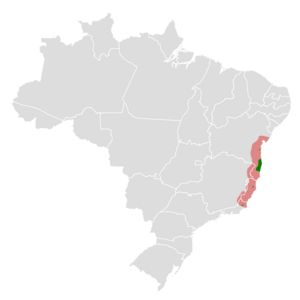Striated softtail facts for kids
Quick facts for kids Striated softtail |
|
|---|---|
 |
|
| Conservation status | |
| Scientific classification | |
| Genus: |
Thripophaga
|
| Species: |
macroura
|
 |
|
The striated softtail (Thripophaga macroura) is a special type of bird found only in eastern Brazil. It belongs to the ovenbird family called Furnariidae. This bird is considered a Vulnerable species, which means it needs our help to protect it.
Contents
About the Striated Softtail
What Does the Striated Softtail Look Like?
The striated softtail is about 17 to 18 centimeters (about 7 inches) long. Both male and female birds look very similar. They have a brown face with light streaks and a pale stripe above their eye.
Their back, rump, and upper tail feathers are dark reddish-brown. These parts have streaks that are reddish-orange to buff-colored, edged with black. Their tail is a light reddish-brown. Their wings are mostly dark reddish-brown with darker tips on the flight feathers.
The bird's chin and upper throat are bright orange or yellowish-orange. The rest of their belly is dull brown with buff streaks. These streaks become lighter on their lower belly. Their eyes are a deep chestnut brown. Their beak is partly dark gray and partly bluish-gray. Their legs and feet are a dull greenish-gray.
Young softtails look a bit different. Their chin and throat are dull brown. The streaks on their back are not as clear as on adults. Their belly looks mottled (blotchy) instead of streaked.
Where Do Striated Softtails Live?
The striated softtail lives along the coast of southeastern Brazil. You can find them from the southern part of Bahia state down to the northern part of Rio de Janeiro state.
They like to live in tropical lowland evergreen forests. They especially enjoy areas with lots of dense vines. These birds can be found from sea level up to about 1,000 meters (3,300 feet) high.
Striated Softtail Behavior
How Striated Softtails Move Around
Striated softtails do not migrate. They stay in the same area all year long. This means they are residents of their habitat.
What Do Striated Softtails Eat?
Striated softtails eat arthropods, which are creatures like insects and spiders. They look for food by themselves, in pairs, or in small family groups. Often, they join a mixed-species feeding flock. This is when different kinds of birds feed together.
They search for their prey from the lower parts of the forest up to the middle layers of trees. They mostly find food in thick vine tangles. But they also look along branches and in leaves.
Striated Softtail Reproduction and Nests
Scientists are still learning about when striated softtails breed. However, active nests have been found between September and January.
Their nest is shaped like a ball. It is made from grass, moss, small twigs, and rootlets. The nest has a special entrance tube at the bottom. They usually build their nest in a tree branch fork. This is often high up, about 10 to 25 meters (33 to 82 feet) above the ground.
A female softtail usually lays three eggs. We don't know how long the eggs take to hatch or how long it takes for the young birds to leave the nest. We also don't know much about how the parents care for their chicks.
Striated Softtail Sounds
The song of the striated softtail is a mix of short rattling sounds. It also includes "tjew-tjew-tjew" notes and chattering sounds, like a sparrow. Sometimes, two birds will sing together in a duet. Their call is a loud "kit-kit-kit."
Protecting the Striated Softtail
The IUCN (International Union for Conservation of Nature) helps track how safe different species are. They first listed the striated softtail as "Threatened." Then, it was changed to "Vulnerable" in 1994. In 2000, it became "Endangered," which is a more serious level. But since 2004, it has been listed as "Vulnerable" again.
This bird has a small area where it lives. Experts believe there are only about 1,500 to 7,000 adult birds left. Their numbers are thought to be going down.
A big problem for these birds is habitat destruction. This means their forest homes are being cut down or changed. This has broken up their living areas into smaller pieces. Even though they have been seen in forests that are not perfect, they might need dense vine tangles to survive. These vines are usually found in older, undisturbed forests.
The striated softtail lives in some protected areas. However, their population is spread out unevenly. Brazilian authorities also consider this bird to be Vulnerable. It's important to protect their forest homes so these unique birds can thrive.


